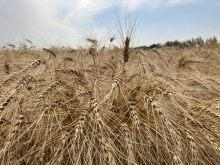Average values of farmland in Farm Credit Canada’s cross-country review climbed 10 per cent during the second half of 2012, led by double-digit increases in Quebec, Manitoba and Ontario.
The federal ag lender’s spring 2013 Farmland Values report, based on a system that monitors 245 benchmark properties across the country, logged its biggest average national increase in land values since the agency began its reports in 1985.
It follows the second-highest increase in the report’s history, which occurred in the first half of 2012, at 8.6 per cent. The average national value hasn’t dropped since 2000, when it slipped by 0.6 per cent.
Read Also

U.S. grains: Corn, wheat ease after gains driven by Black Sea jitters
Chicago | Reuters – U.S. corn futures fell on Wednesday and wheat futures also dipped as fears eased about a…
“Strong crop receipts create a favourable environment for higher farmland values,” J.P. Gervais, FCC’s chief agricultural economist, said in the lender’s release Monday. “Low interest rates make it easier for producers to consider expanding their farm operation.”
That said, Gervais cautioned farmland buyers to do their homework and ensure their budgets have room to flex, should commodity prices fall back from current highs or interest rates rise to more traditional levels.
There remains some concern that farm debt in Canada is increasing, but “net farm income — especially in the grain and oilseed sector — has roughly increased at the same pace,” Michael Hoffort, FCC’s senior vice-president of portfolio and credit risk, said in the same release.
Farmland values in Quebec have never seen a decrease in FCC’s reviews, and saw the highest increase in the country in the last half of 2012 at an average of 19.4 per cent. That hike follows increases of 6.7 and 4.3 per cent in the previous two reporting periods.
Quebec’s major farmland buyers were producers expanding their operations, FCC said. Demand was high throughout the province but strongest in the Monteregie, Centre-du-Quebec and Lanaudiere regions and in part of the Laurentides.
In Manitoba, where land values have risen consistently since 2001, FCC’s average of surveyed farmland values rose 13.9 per cent in the second half of 2012. That marks the province’s highest-ever increase in the survey’s history and comes after increases of 10.3 and 1.9 per cent in the previous two six-month periods.
Strong commodity and cattle prices and low interest rates, combined with continued consolidation of the industry and interest from out-of-province buyers, helped punch up values, FCC said.
Average values in Ontario have risen for the past 20 years and were up an average of 11.9 per cent in the second half of 2012, following gains of 16.3 and 7.2 per cent.
Demand was strong from dairy and larger livestock enterprises, as well as from cash crop operators wanting to expand their land bases, FCC said. Some producers set to exit the industry chose to sell off their land rather than collect rent as landlords.
Saskatchewan has booked increases in average farmland values since 2002, and saw values rise 9.7 per cent in the last half of 2012, after increases of 9.1 and 10.1 per cent in the previous two periods.
“Most increases occurred in areas that had previously experienced flooding and had, as a result, seen few changes in the past two years,” FCC said of Saskatchewan’s land values. Demand for higher-quality, clay-based land continued, but prices for such land tended to stay stable over the report period; lower-valued lands have seen a greater increase.
Interest from out-of-province buyers continued, FCC said, but noted many land sales in the province weren’t advertised as many landlords sold privately to their tenants. Some retiring farmers sold land en masse to take advantage of strong prices.
Alberta’s average land values rose 7.2 per cent during the period covered in Monday’s report, up from increases of 5.7 and 4.5 per cent in the previous two periods.
Values have been rising in the province since 1993, FCC noted, and higher commodity prices and strong demand along the Highway 2 corridor have boosted values in that area. Irrigated areas in the south of the province also saw high demand.
Land prices in Nova Scotia’s western region led the province to a 6.8 per cent increase in average farmland value in the last six months of 2012, up from increases of 2.8 and 3.2 per cent in the previous two periods.
Higher feed costs have boosted competition among livestock producers for land to grow their own feed, FCC said, while demand from “lifestyle farmers and Halifax commuters” continued in the Colchester/East Hants area.
Average farmland values on Prince Edward Island rose 5.7 per cent over the report period, up from 3.1 and 1.5 per cent in the previous two. Confidence in the potato industry following a third year of strong yields was reflected in higher farmland prices, FCC said, while interest from large organic farms and soybean growers also supported land values.
British Columbia, meanwhile, saw nearly flat average farmland values, increasing just 0.4 per cent during the report period, following a slip of 0.3 per cent in the previous period and a 0.2 per cent increase in the last half of 2011.
Prices were relatively stable in most regions of mainland B.C. and Vancouver Island saw a “limited” number of farm property sales, reflecting the region’s real estate market.
Values in New Brunswick and Newfoundland and Labrador remained flat during the report period. Outside potato-growing regions of New Brunswick, market activity was “more limited” due to low demand and consolidation in the ag sector previous years.
Newfoundland and Labrador, meanwhile, continues to operate a land consolidation program, to buy and lease back parcels to active farmers to help maintain productive farmland. “Since these sales aren’t available to the public and farmland sales between individuals are uncommon, there were no sales available that would allow proper monitoring of farmland values during the reporting period,” FCC said.
FCC has issued reports on average farmland values every six months since 1990, but said Monday it will now return to an annual review and will issue its next report in the spring of 2014.
Related story:
Ontario, Manitoba book biggest gains in farmland values, Oct. 11, 2012














